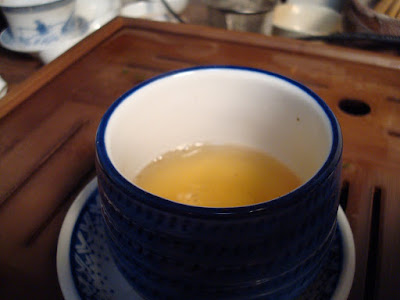
Alright so In my Last order from Chinese Kung fu Tea Arts, I got a digital scale, so I will now try and post the number of grams per size of vessel I am using. In that was also 250g of each of his Aged TGY. I do not quite like the fact that I only learned through talking with him that he has two different types of Aged TGY both from 2001 ( I think) but he only has one post on his site. As the Aged TGY I reviewed before was the Red foil bag, which is not the one he has actively been selling.
Though He does say that he likes the Blue foil bag better. Perhaps it is just this bag but the leaves seem slightly more broken up, but they have a distinct nice sweetness. I am using 1 packet (roughly 8g) in my 100 ml gaiwan.
From the leaves after the rinse came a great peach like aroma, I only hope that carries through for the infusions. The aroma of the broth is subtle in nature, but there is a unique peach, spices and herb like aroma coming from it but not a powerful peach like the smell of the wet leaves. There is a slight hint of a roasting present. The broth is interesting, very satisfying but not potent. I will have to steep it longer ( I did roughly 25 seconds on this one). But there is a roasted note, combined with notes of a wide variety of fruits, oranges and peaches to name a few.
Its mouth feel is not bad though, its almost oily, in the way it coats everything.
The Second infusion smells Sweeter, while the taste in this 40 second infusion is much more pronounced, and there is something distinctly citrus like in there. But it is far from the sourness that can be associated with aged oolongs.
at the price of around 50 dollars for 500 grams I knew this would be nothing to write home about, but I have 300 grams in storage for years down the road, and the rest I'll be happy to drink occasionally as a casual drinker.
Perhaps it is the smaller leaf to water ratio, but I feel the blue foil pouch does not last as long as the red foil pouch, though it is still satisfying on the 7th infusion or so it is little more than sweet water.

















